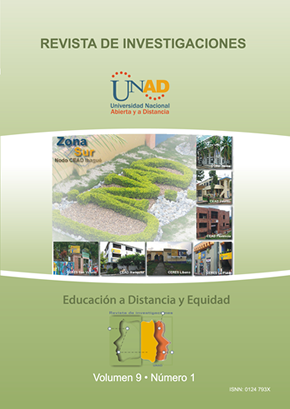Cuando la REVISTA DE INVESTIGACIONES UNAD recibe la postulación de un original por parte de su autor, ya sea a través de correo electrónico o postal, considera que puede publicarse en formatos físicos y/o electrónicos y facilitar su inclusión en bases de datos, hemerotecas y demás sistemas y procesos de indexación. REVISTA DE INVESTIGACIONES UNAD autoriza la reproducción y citación del material de la revista, siempre y cuando se indique de manera explícita el nombre de la revista, los autores, el título del artículo, volumen, número y páginas. Las ideas y conceptos expresados en los artículos son responsabilidad de los autores y en ningún caso reflejan las políticas institucionales de la UNAD
Modelado del alumno en juegos educativos gestionados con gentes SOFTWARE (JuEGAS) multifuncionales, el caso JuEGAS_ProVEAS
El presente artículo describe los criterios para estructurar el modelado del alumno en un “Video juego educativo gestionado con agentes software (JuEGAS)” multifuncional, usando como piloto el caso JuEGAS “Problemas de naturaleza verbal de estructura aditiva y sustractiva (ProVEAS)”. El modelado del alumno se define como el estado actual de conocimiento que tiene el estudiante sobre un dominio temático.
El sistema multifuncional antes mencionado hace referencia a un software educativo que le brinda al docente la posibilidad de evaluar, ejercitar y tutorizar a los estudiantes en un dominio temático. En este caso, ese dominio corresponde a los problemas de naturaleza verbal de estructura aditiva y sustractiva y a las estrategias utilizadas por los niños entre 7 y 9
años para solucionar este tipo de problemas. En este orden de ideas, el modelado del alumno se creó con la posibilidad de permitir al software funcionar de manera dinámica en la medida en que se construye, por lo que se convierte en una estructura novedosa para el desarrollo de un JuEGAS ProVEAS multifuncional.
Para representar este modelo en el sistema se hace uso de la estructura de la red bayesiana y se diseña el “modelo unificado” como nueva propuesta en los diferentes tipos de modelados del alumno, existentes. Además, se definen ocho criterios indispensables a la hora de realizar el modelado del alumno con ayuda de la metodología “Software educativo, colaborativo, multimedia, adaptativo, lúdico e interactivo (secmali)” (Giraldo, 2007). La investigación utiliza el enfoque cualitativo, teniendo en cuenta un diseño exploratorio-explicativo y el método modelación que hace parte de la clasificación de los métodos de investigación y desarrollo de la informática definidos por (Barchini, 2005).




